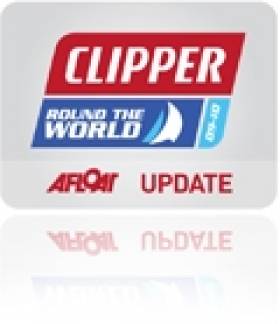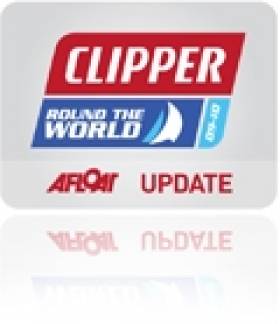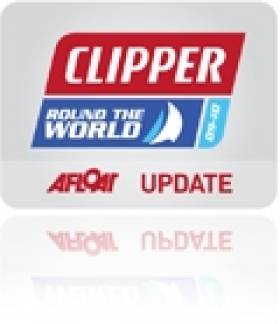Displaying items by tag: Clipper Race
Clipper Secures Chinese Entry Until 2016 in Major Sponsorship Deal
#CLIPPER – Clipper Ventures Plc announced at the London Boat Show today that it has signed a major sponsorship deal with Qingdao, host of the sailing events of the Beijing 2008 Olympic Games, to continue its participation in the Clipper Round the World Yacht Race through to 2016.
Qingdao has fielded an entry and hosted the event since 2005 and has credited the Clipper Race with helping it not only prepare for hosting the Olympics but also in developing its brand as China's Sailing City. It will now become the first destination in the world to sponsor six editions of the unique biennial event.
"This is excellent news," said William Ward, chief executive of Clipper Ventures. "I am proud of the role the Clipper Race has played in helping Qingdao to be successful, promoting its sailing achievements and helping to tell its story around the world. It also brings our sponsors together in Qingdao to stimulate international trade between China and the rest of the world."
Madam Lin Zhiwei, Chairman of Qingdao Sports Federation, said, "We have decided to continue our collaboration in Clipper 13-14 and Clipper 15-16. It has become an important event to build our brand as the Sailing City of China."
New fleet
The construction of an innovative new fleet of 12 Clipper 70 yachts, with an option for a further four, is progressing on schedule in China. It will be the world's biggest matched fleet of large ocean racing yachts. UK based suppliers of equipment and services are also being signed up for the new fleet and future races.
Speaking on the opening day of the 2012 London Boat Show, Clipper Ventures founder and chairman Sir Robin Knox-Johnston said, "The manufacture of the Clipper 70s is now well underway and will help us to meet the growing demand from crew and sponsors with a forward programme through to 2020."
The legendary British yachtsman added, "The Clipper Race is unique in world business and I believe our own performance demonstrates that the UK marine sector has great potential and needs to be celebrated. Clipper Ventures puts millions of pounds into the local economy around its base in Portsmouth Harbour every year and our high proportion of overseas income makes a positive contribution to Britain's Balance of Payments."
The eighth edition of the Clipper Race, Clipper 11-12, is currently halfway through its 40,000-mile circumnavigation en route from the Gold Coast, Australia, to Qingdao via Singapore. The fleet will reach Marina at Keppel Bay, Singapore, on 28 January and the yachts are expected to begin arriving at the Qingdao International Marina and Olympic Sailing Center from 22 February.
Bon Voyage to the crew of the Derry-Londonderry yacht
"We know this is a huge challenge for them all," says Harbour Master Bill McCann, "but they have had superb training from the Clipper team and we are confident that they are up to the challenge."
Harbour Commissioner Roy Devine, who will join the race in New York for the final leg, says he is thinking particularly about the 10 crew members who are taking the entire round the world trip. "It is a huge undertaking and I really respect them for it. I also send best wishes to the whole crew and hope they race well and race safely."
The Derry~Londonderry yacht take 11 months to cross 15 seas and oceans before completing their arduous journey. The 8-leg race, which stops over at Derry in the final leg, is made up of 15 individual races, and boats score points mainly for how they perform in each of these races (10 points for first, 1 for last etc). The Clipper Trophy goes to the yacht with the highest total at the Finish Line in July 2012.
Find out more about the Derry Londonderry team at www.derrycity.gov.uk/clipper or follow the team on Facebook at Derry-Londonderry Clipper 11-12.
Boats Head for 'Foyle Days' 2011
Over the years she has changed hands between Dutch and UK interests for recreational use. Several years ago she starred in the RTE TV reality show 'Cabin Fever' where she replaced the show's first ship Camaret of Cornwall (branded as 'Cabin Fever') after it ran aground off Tory Island.
During the two-day festival (11am-5pm) the boating community at the event will include the Coleraine Yacht Club, Foyle Paddlers, Foyle Punts, Lough Foyle Yacht Club, Lough Swilly Yacht Club, Moville Boat Club, RNLI and the Foyle (SAR) Search and Rescue.
Visitors to Foyle Days can call to the Clipper stand and learn more about the city's entry of the Derry~Londonderry boat in the 2011-2012 Clipper Round the World Race. Learn more about the countries the crew will visit and also how to get involved in the event. For more information about the race, at 40,000 miles is the world's longest race go to www.clipperroundtheworld.com/
Running alongside the festival a continental market with 40 stalls will be open to all at the recently revamped Guildhall Square. For further details about Foyle Days click here.
- Clipper Race
- Maritime Festival
- RNLI
- Lough Foyle Yacht Club
- Lough Swilly Yacht Club
- Moville Boat Club
- Derry
- Londonderry
- Tory Island
- JOHANNA LUCRETIA
- Foyle Days
- RTE TV
- Cabin Fever
- Camaret of Cornwall
- Grounding
- Reality TV show
- Clipper Around the World Race
- Guildhall Square
- Continental Market
- Coleraine Yacht Club
- Foyle Search and Rescue
- Foyle Paddlers
- Foyle Punts
- Offshore Sailing
- Clipper Round The World Race
- JOHANNA LUCRETIA
Art Exhibition to Celebrate Clipper Round the World Festival
To celebrate the arrival of the Clipper Round the World Race to Ireland, Kinsale Arts Week has invited each of the countries participating in the Yacht Race to select an artist to represent them at an exhibition. The Clipper Round the World Race is expected to arrive in Kinsale, Co. Cork from 2nd - 7th July, when the town will host the Kinsale Clipper Carnival.
The selected works will be showcased as part of an exhibition titled “Stopover” at the Art Hub at the Mill, opposite St. Multose Church. This is the first Exhibition at the building, which has been beautifully, and sensitively, renovated by Kinsale Town Council and Cork County Council, and will be a permanent legacy of the Carnival.
“Stopover” is intended to create a cultural dialogue between the participating countries as well as promoting the diverse cultures in an event that reflects the global scale of the Clipper Race itself. The exhibition is free and is open daily, from Saturday 3rd to Sunday 18th July, from 10am to 6pm.
Other highlights of the Carnival Weekend include “Ebb-Tide-Flow” an audio-guided walk on mp3 players. Designed by artist Fiona Hallinan and composer Alex Synge, the tour is accompanied by an original map and comprises a score and original text written for the Scilly walk. Also during the weekend children and adults will be invited to come to the Methodist Church in the town to make a page for “The Clipper Adventure Book”. The book will follow the journey of the Clippers around the world and will then be exhibited for the year at the local library.
One of the centrepieces of the Carnival Weekend will be Live Music at the Square with local, national and international acts throughout Saturday and Sunday featuring artists such as Ian Whitty and The Exchange; Aaron Dillon and Band; Novella Hermosa and Txutxukan.
Friday, July 2nd, will see the Kinsale Clipper Burrells. A Burrell is an evening of music in different venues, where instead of the audience travelling to see different acts in different venues, the acts come to each venue in turn. There will also be Kinsale Historical Walks with Dermot Ryan daily at 10.30am and 3pm from the Tourist Office.
The culmination of the weekend, on Sunday 4th July, will be the Kinsale Clipper Parade where the streets of Kinsale will be transformed into the mighty trade routes - from Asia to Europe - that the Clippers of old sailed along. The Kinsale Clipper Carnival is sponsored by Cork County Council, Cork City Council and Fáilte Ireland.
For more details on the exhibition or the Clipper race visit www.kinsaleartsweek.com or www.corkclipperfestival.com
Clipper Fleet Leaves Jamaica
Cork has made a mediocre start to Race 10 from Jamaica to New York as the latest stage of the Clipper 09-10 Round the World Yacht Race gets under way. The team was sixth to cross the start line and held their position around the first mark and as they headed for the Windward Passage between Cuba and Haiti.
Cape Breton Island’s eagle got a flying start ahead of the rest of the ten-strong fleet. In eight to ten knots of breeze from the east and a very calm sea state, Uniquely Singapore was next to cross the start line, followed by Team Finland and Spirit of Australia. Jamaica Lightning Bolt was mid pack, followed by Cork, Ireland and Hull & Humber, with Edinburgh Inspiring Capital, California and Qingdao completing the order.
California had crossed the line ahead of the starting signal, so were forced to go around again to exonerate themselves, while Qingdao misjudged the amount of time they needed to get to the line from their training session and were last to cross, 20 minutes after the signal was sounded at 1410 (1910 GMT).
At the mark, Team Finland had gained ground, tacking up the course to round ahead of Cape Breton Island, Spirit of Australia followed the Canadian yacht and Uniquely Singapore steamed in ahead of Jamaica Lightning Bolt, leaving the home team in their dirty air, to good natured shouts of protest from home team supporters close by.
The 1420-mile race to New York, the latest stage of the 35,000-mile circumnavigation, will take them past the island of Cuba and up the east coast of North America, following the Gulf Stream current.
Preparing to leave Port Antonio where the fleet has been enjoying Jamaican hospitality since their arrival last Tuesday, the skipper of the Irish boat, Hannah Jenner, said, “We’re all set, the boat’s looking much better, she’s a bit lighter and everyone’s had more time on her. We’re looking forward to getting going – slightly worried about the light winds but we’ll see, you never know. We’ve obviously got the home port coming up so we’ve got to get the boat up to speed by Kinsale so we can get a good result in the race there.”
The Clipper fleet is due to arrive in Kinsale from 1 July before moving on to Cork city during the eight day stopover in Ireland.
Double world record holder, Usain Bolt, after whom the Jamaican entry is named, sent a message to the teams during the stopover. He said, “Sorry I couldn’t be here to welcome you personally to the most incredibly beautiful paradise in the world but I have some work to do in China. Like you, I am also on a round the world mission, just a little faster though – the way I like to do things! Big respect to all of you competing in this incredible race. In fact, ‘nuff respect, as we say in Jamaica. You are all champions. So I guess it makes sense that you would be here in Jamaica, the land of champions.”
Joff Bailey, Race Director said, “We’ve had a great stopover in Jamaica and everyone is looking forward to this race. The skippers are all fired up for this last leg, pushing for the last points that will secure the podium positions. The winds will be light for the first part of the race but once the fleet gets north of the Bahamas it will be a great sail up to New York.”
The ten internationally-backed ocean racing yachts slipped their moorings in Errol Flynn Marina at 10am local time (1500 GMT) and sailed out of the harbour past Port Antonio’s iconic orange and white lighthouse where local residents, enjoying the Labour Day holiday, were waiting to wave off the boats.
After a training session the teams gathered near the start line at Folly Point Lighthouse, the Jamaica Defence Force Coast Guard cutter, HMJS Cornwall, at the other end of the start line.
Joff said, “I’d like to thank Captain Batchelor and the crew of HMJS Cornwall for their assistance and hospitality today, as well as the crew on Southern Cross who did a great job of holding position as the windward mark while the yachts passed within feet of them.”
During the short stopover in Jamaica the Member of Parliament for East Portland, Dr Donald Rhodd, attended the prize-giving ceremony and said, “We are very humbled that this prestigious event has come to our shores. Your sportsmanship must be applauded as well as your levels of professionalism with which you execute your craft. I wish you success as you travel to your next port of call. Our people in general and tourism in particular have been the beneficiaries of your short stay with us. I hope the warmth and hospitality here have helped to strengthen the bonds of friendship amongst our peoples and I’m sure you will return. We will welcome you again with open arms.”
He also had a message for the rest of the crews: “I’d like to remind you the honourable Lightning Bolt, Usain Bolt, doesn’t come second in a race! So for all of you out there, watch out, he’s coming for you!”
The fleet is due to arrive in New York between 2 and 3 June.
With 93 points, Spirit of Australia currently leads the overall standings in the Clipper 09-10 Round the World Yacht Race, 18.7 points ahead of Team Finland, with Jamaica Lightning Bolt just three-tenths of a point behind them in third place. Cape Breton Island is currently fourth overall. Five races remain in the 14-race series, which will finish on 17 July when the ten yachts race up the Humber to the city of Hul


































































